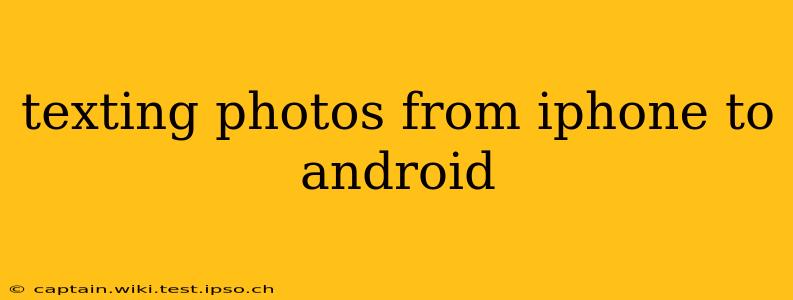Sending photos between iPhones and Android devices can sometimes feel like navigating a technological minefield. But fear not! This comprehensive guide will walk you through various methods, troubleshooting common issues, and ensuring a smooth picture-sharing experience. We'll cover everything from the simplest techniques to advanced solutions, ensuring you can effortlessly share your precious memories across platforms.
Why is Sending Photos from iPhone to Android Sometimes Difficult?
The primary reason for occasional difficulties stems from the inherent differences between Apple's iMessage and Android's messaging systems. iMessage, optimized for Apple devices, uses a different protocol than the standard SMS/MMS used by Android. This difference can lead to compatibility issues, especially when sending high-resolution images. Furthermore, various messaging apps introduce their own sets of limitations and features.
How to Text Photos from iPhone to Android: Different Methods
Here are several ways to send pictures from your iPhone to an Android phone, each with its own pros and cons:
1. Using Standard SMS/MMS Messaging (for smaller images)
This is the simplest method, but it's best suited for smaller images. Larger photos may be compressed significantly, leading to a loss of quality.
-
How to: Open your messaging app, select the recipient, and choose the photo you wish to send. The phone will automatically determine if it can send it as an MMS message. If the photo is too large, it might ask you to compress it.
-
Pros: Easy and readily available.
-
Cons: Image quality can suffer, and larger files might fail to send.
2. Using iMessage (if both devices are registered with Apple ID)
If both your iPhone and the Android device have active Apple IDs and iMessage is enabled, you might be able to send photos this way. However, the recipient must have iMessage configured to receive them.
- How to: Open iMessage, select the recipient (who must also be using iMessage), and send the picture as you normally would.
- Pros: Maintains higher image quality than MMS.
- Cons: Only works if the Android device is also registered with Apple ID and actively using iMessage.
3. Utilizing Third-Party Messaging Apps (WhatsApp, Telegram, etc.)
Many popular messaging apps like WhatsApp, Telegram, and Facebook Messenger overcome the limitations of SMS/MMS and iMessage. These apps work seamlessly across platforms.
- How to: Open your preferred app, select the recipient, and send the image.
- Pros: High-quality image transfer, works across operating systems.
- Cons: Requires both parties to have the app installed.
4. Utilizing Cloud Services (Google Drive, iCloud, Dropbox)
Cloud services offer another excellent solution. Upload your photo to your chosen service and share the link with the Android user.
- How to: Upload the picture to Google Drive, iCloud, or Dropbox. Share the link with the recipient.
- Pros: Maintains original image quality, avoids messaging limitations.
- Cons: Requires an internet connection for both uploading and downloading.
5. Email
Sending photos via email is a straightforward method, particularly for larger images or multiple photos.
- How to: Attach the photos to an email and send them to the recipient.
- Pros: Simple, reliable, works for large files.
- Cons: Not as immediate as instant messaging.
Troubleshooting Common Issues
- Image too large: If you encounter this error, try compressing the image using a photo editing app before sending it via SMS/MMS or email.
- Message not sent: Double-check your internet connection. If using a third-party app, ensure it's properly configured and signed in. For SMS/MMS, ensure your phone's settings allow MMS messaging.
- Poor image quality: Using SMS/MMS often reduces image quality. Use a different method (third-party apps, cloud services, email) for better results.
Which Method is Best for You?
The ideal method depends on several factors: image size, the urgency of sending, whether both parties have the same app installed, and the available internet connection. For smaller photos and quick transfers, SMS/MMS or a third-party app is ideal. For larger, higher-quality images, cloud services or email are often preferred.
This guide aims to provide a comprehensive overview of sending pictures from iPhones to Android devices, equipping you with the knowledge to choose the most efficient and effective method for your needs. Remember to always consider factors like image size, recipient availability, and the urgency of sending when choosing a method.
